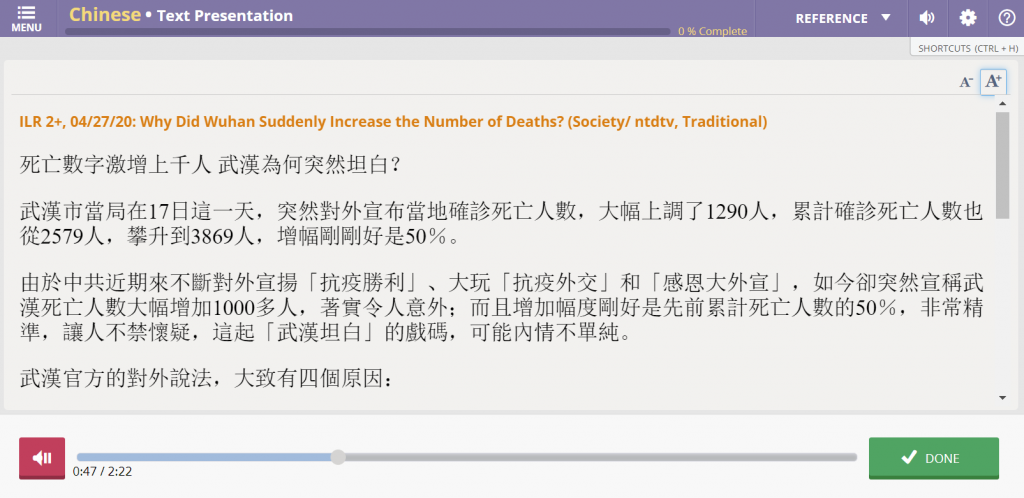CL-150 Cohort Lesson of the Month – April 2020 Posted by meaghan on May 11, 2020 in Cohort Lesson of the Month, For Learners, For Program Managers
Looking for recent, relevant learning materials for on-the-job sustainment? The CL-150 Cohort team has already published more than 500 new lessons so far this year, covering current events that range from a waste management crisis in Lebanon to the US meetings with the Taliban to, of course, COVID-19.
This month’s featured lesson does indeed cover COVID-19, in particular the unexplained drop in deaths reported in Wuhan, China. While it’s one of the most pressing questions in global health right now, that’s not the reason we’re featuring this lesson! What makes this lesson special is that it’s one of the first to highlight traditional Chinese characters.

What are CL-150 Cohorts?
If you’re not familiar, CL-150 Cohorts are weekly lesson streams designed specifically for USG language professionals maintaining proficiency on the job. Each lesson provides a 2-hour “workout” at a specific ILR level, based on a professionally relevant, authentic source.
Why traditional Chinese?
There are two variations of the Chinese writing system: simplified and traditional. While most native Chinese speakers will recognize both, there are reasons to learn one or the other.
Simplified Chinese was designed in the 1950s and 60s, as the name suggests, to simplify the language in terms of number of characters and number of strokes per character. Mainland China and Singapore now use predominantly simplified Chinese, and the bulk of modern, online writing, as well as most research and technical materials, are only available in simplified.
So, what is traditional Chinese and why would we choose to highlight it in a Cohort lesson? Traditional Chinese also takes after its name, as it’s the language of poetry, literature, and art. However, traditional is also still the primary system used in Taiwan, Hong Kong, and Macau. According to our Chinese lesson author, Li, learning traditional Chinese is useful for many reasons:
“Obviously if you plan to work in Taiwan, Hong Kong, or Macau, it’s important to know Traditional Chinese. But even in mainland China, there is a certain prestige that comes with knowing Traditional characters. Shop signs and advertisements in China sometimes use traditional characters to create an elegant appearance.
Also, Chinese characters used in written Japanese and Korean are also much closer to traditional Chinese characters. This will give you a leg up if you need to understand some level of those languages as well.”
There are several hundred simplified Chinese characters that are so different from the traditional characters that even people who read and write traditional Chinese fluently need to memorize the simplified versions.
Teaching traditional in Cohort lessons
This month’s Cohort lesson of the month comes from the ILR 2+ Chinese lesson stream: ILR 2+, 04/27/20: Why Did Wuhan Suddenly Increase the Number of Deaths? (Society/ ntdtv, Traditional)

The lesson text is from an authentic news article written in traditional characters. For further practice, Li also used traditional in each of the lesson’s learning activities, including the vocabulary, reading and listening comprehension questions, etc.
While some characters are the same in both writing systems, many simplified characters differ to make them easier to read and write. Of the 14 key words and phrases chosen from the text to be used in vocab activities, 11 differ from their simplified counterparts. So even if a learner has already learned some of the vocabulary in simplified, the traditional form will be new to them—expanding not only the breadth but also the depth of their Chinese knowledge.

This is one small example of how CL-150 Cohorts are evolving over time to better meet the needs of sustainers maintaining and enhancing proficiency on the job. If you have suggestions of how we might improve the Cohort lesson streams to meet your organization’s needs, we’d love to hear your feedback in this quick survey!


